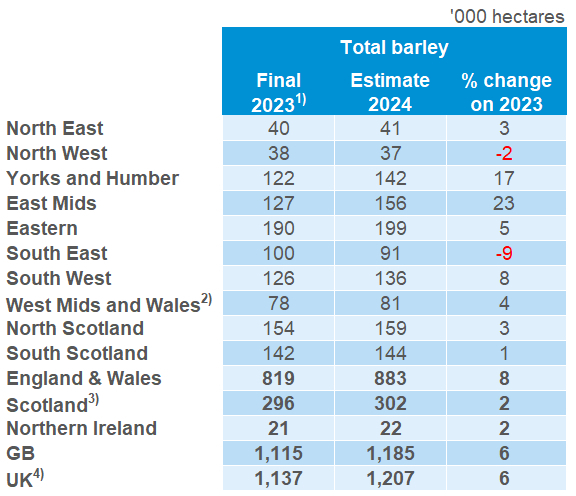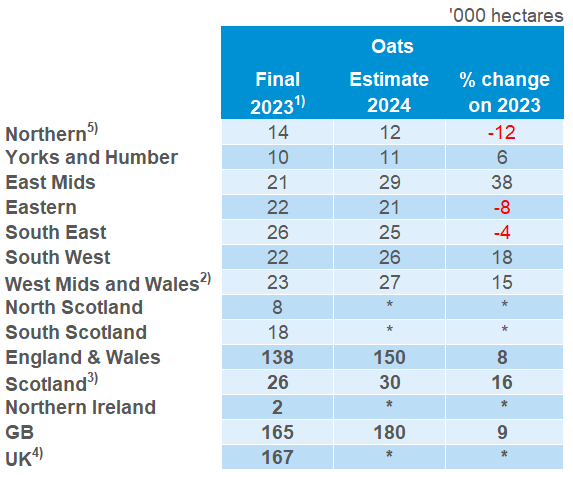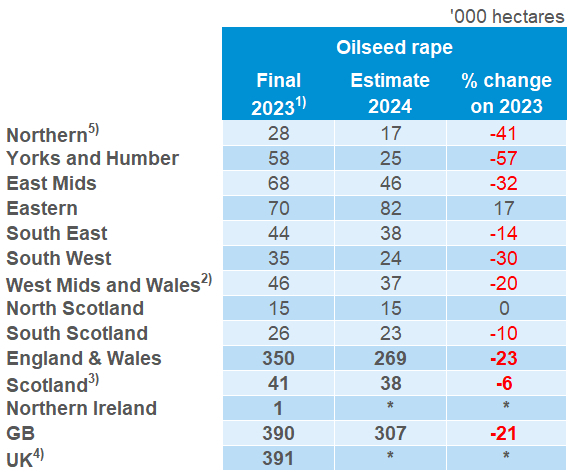- Home
- Markets and prices
- Cereals and oilseeds markets - Supply and demand - Planting and Variety Survey
Planting and Variety Survey
The Planting and Variety Survey provides the UK planted area estimates for the upcoming harvest. Broken down not only into crops but also by UK flour miller group and malting or non-malting approved barley.
Overview
This year’s Planting and Variety Survey provides planted area estimates for the UK with a regional breakdown.
For the UK
- The total wheat area is estimated to be 1,560 Kha, 9% down on the year. This is the second smallest planted area since 1981, behind 2020
- The total barley area is up by 6%, at 1,207 Kha. However, this is only 1% over the five-year average
- The spring barley area rose considerably (18%) to an estimated 804 Kha, the third largest area since the turn of the century
- Winter barley fell by 12% to 402 Kha; 2% below the five-year average
For GB
- The oats area is estimated at 180 Kha, a 9% increase from last year. While this is historically high, the area is 2% below the five-year average
- The OSR area is estimated to decline by 21% to 307 Kha. This would be the second-lowest area in at least two decades and 59% below the peak area in 2012 for the same period
- Total cereals area falls by 3% to 2,916 Kha, the lowest area since 2007
- Total cereals and oilseeds area falls by 5% to 3,223 Kha, the lowest area since at least the turn of the century, notably pressured by a historically low OSR area
This year’s Planting and Variety Survey also collected data regarding the Sustainable Farming Incentive (SFI) environmental scheme to help offer insight regarding uptake. This data will be made available soon.
Wheat
While larger than the wheat area of 2020 by 12%, the 2024 UK wheat area is estimated to be the second smallest wheat area since 1981 at 1,560 Kha.
The considerably challenging conditions for winter crops, in addition to restricted opportunities for spring drilling, resulted in a 9% fall for UK wheat area.
Although this year-on-year fall in area is not as large as suggested by the Early Bird Survey, many growers may not have had the opportunity to re-plant wheat crops in poor condition. Therefore, in addition to being a smaller area, conditions are also under pressure.
Most regions in the UK experienced a decline of varying degrees, though a stable wheat area is reported in the North East, with a small rise in Northern Ireland.
Eastern England and the East Midlands faced the largest declines in wheat area, together down 76 Kha.
Year-on-year, as a percentage of the area, UK flour Group 1 remains relatively stable across GB at 24%. It is important to note that while area share is broadly stable, the hectarage has fallen considerably as a result of the smaller wheat area.
The Group 2 share has fallen from 21% in 2023 to 19% this year, while the Group 3 share halved from 4% to 2%. Therefore, and especially when considering current crop conditions as well, production of these varieties is likely to fall on the year.
Meanwhile, the area share of Group 4 has gained. Group 4s have been estimated to cover 49% of GB wheat area in 2024, the highest share since 2016.
Group 4 KWS Dawsum is the most prevalent wheat variety in GB at 17% of area. Crusoe and Skyfall remain the top choices for Group 1s, both accounting for 9% respectively of the GB wheat area.
Among Group 2s, KWS Extase area has dropped 3 percentage points on the year, estimated to account for 14% of the 2024 GB wheat area.
Wheat area estimates

Barley
As broadly anticipated, the UK’s spring barley area saw a notable increase.
So, despite the drop in winter barley area, total barley area in the UK is expected to rise on the year by 6% to 1,207 Kha. This would be the largest total barley area since 2020.
Rises in the share of malting, brewing and distilling varieties are supported by the increase in spring barley planting.
Across GB, total malting, brewing and distilling varieties account for 68% of area (up from 57% in 2023), while total feed and other only accounts for 32%.
For the fourth year in a row, Laureate is the most prevalent barley variety with its popularity rising from last year. Laureate accounts for 40% of the GB barley area in 2024.
Winter barley
For the UK, winter barley is estimated at 402 Kha, down 12% on the year from a sizable 2023 area.
Across the UK, the winter barley area only rose in the North East, declining in all other regions by varying degree.
The largest drop in area by hectarage was seen in Eastern England, estimated to fall 20 Kha to 77 Kha.
Spring barley
Following the eleventh wettest autumn on record (since 1836), spring barley looked to be an attractive option for cereal growers who had not had the opportunity to plant all of their planned winter crops or where winter crops were in too poor a condition to continue with.
For the UK, spring barley area is estimated to be up 18% from last year, at 804 Kha.
While less than farmers had intended in March, this would still be the third-largest spring barley crop since the turn of the century, following 2020 and 2013.
While the area only rose slightly (3%) in Scotland, at 258 Kha, this would still be above the five-year average.
There is expected to be a considerably greater rise in England and Wales to 532 Kha, up 27% from last year.
Total barley area estimates

Oats
The oat area for GB is likely to have been supported by increased spring planting following the challenging autumn.
This year, the oat area is expected to be 180 Kha, up 9% from last year but is still 2% below the five-year average.
Although area for GB is estimated to increase from last year, there were some modest contractions in Northern England, Eastern England, and South East.
However, these reductions were offset by the large 38% year-on-year increase of oat area in the East Midlands, as well as smaller increases seen in other regions across GB.
WPB Isabel is the most prevalent variety accounting for 29.0% of area, followed closely by Mascani at 28.9%. Mascani had been the top variety choice for at least four years.
Oats area estimates

Oilseed rape
Across all the crops reported, OSR saw the largest area decline as a percentage, down 21% year-on-year to 307 Kha. This is the second lowest OSR area in GB since at least 2000 and less than half of the area seen ten years ago.
In addition to the challenging winter weather, OSR remains under pressure from cabbage steam flea beetle. Also, margins have been tightened this year as the crop's value has depreciated considerably since 2022.
There are declines for most areas of GB, the largest proportionally in Yorkshire & The Humber (-57%). There’s a notable rise for the Eastern region of England, up 17%, though the area is still well below the 10-year average.
For the third consecutive year, Aurelia is the top variety choice accounting for 18% of area, with only Acacia and Crome the only other varieties accounting for greater than 5% of area at 6% each.
Oilseed rape area estimates

Additional information
The survey had 1,175 valid responses which cover approximately 5% of the UK total cereals and oilseeds planted area in 2023. The regional representation for wheat was: North East 5%, North West 5%, Yorks and Humber 4%, East Mids 6%, Eastern 6%, South East 5%, South West 5%, West Mids and Wales 4%, North Scotland 7% and South Scotland 8%.
Growers were asked to submit intended harvest areas and the area harvested last year. Data for this survey was collected from 15 April to 14 June 2024.
The following footnotes are used:
- Final 2023 Defra and Scottish Government area data. Please note, the North Scotland and South Scotland OSR figures include 49 hectares of linseed. As a result, the Scottish, GB and UK figures differ slightly from the Defra published statistics.
- West Midlands and Wales have been combined for all crops due to confidentiality.
- The total Scotland figures are derived from the North and South Scotland breakdowns. As a result, the totals differ slightly from the Defra published statistics due to rounding.
- The UK figures are derived from the regional figures. As a result, the totals may differ slightly from the Defra published statistics due to rounding.
- North East and North West have been combined for oats and OSR due to confidentiality.
* Insufficient information to produce robust figure
Regional breakdowns are based on the Nomenclature of Territorial Units for Statistics (NUTS) regions. North Scotland consists of the Highlands & Islands and the North East regions. South Scotland consists of Southern, Eastern and West Central regions.
Please note breakdowns at regional levels are based on smaller sample sizes than at the national level and are therefore subject to more uncertainty.
Historic Spring Planting and Variety Survey results
2024 Planting and Variety Survey Results
2023 Planting and Variety Survey Results
2022 Planting and Variety Survey Results
2021 Planting and Variety Survey Results
2020 Planting and Variety Survey Results
2019 Planting and Variety Survey Results
2019 Variety breakdown by crop
While AHDB seeks to ensure that the information contained on this webpage is accurate at the time of publication, no warranty is given in respect of the information and data provided. You are responsible for how you use the information. To the maximum extent permitted by law, AHDB accepts no liability for loss, damage or injury howsoever caused or suffered (including that caused by negligence) directly or indirectly in relation to the information or data provided in this publication.
All intellectual property rights in the information and data on this webpage belong to or are licensed by AHDB. You are authorised to use such information for your internal business purposes only and you must not provide this information to any other third parties, including further publication of the information, or for commercial gain in any way whatsoever without the prior written permission of AHDB for each third party disclosure, publication or commercial arrangement. For more information, please see our Terms of Use and Privacy Notice or contact the Director of Corporate Affairs at info@ahdb.org.uk © Agriculture and Horticulture Development Board. All rights reserved.

